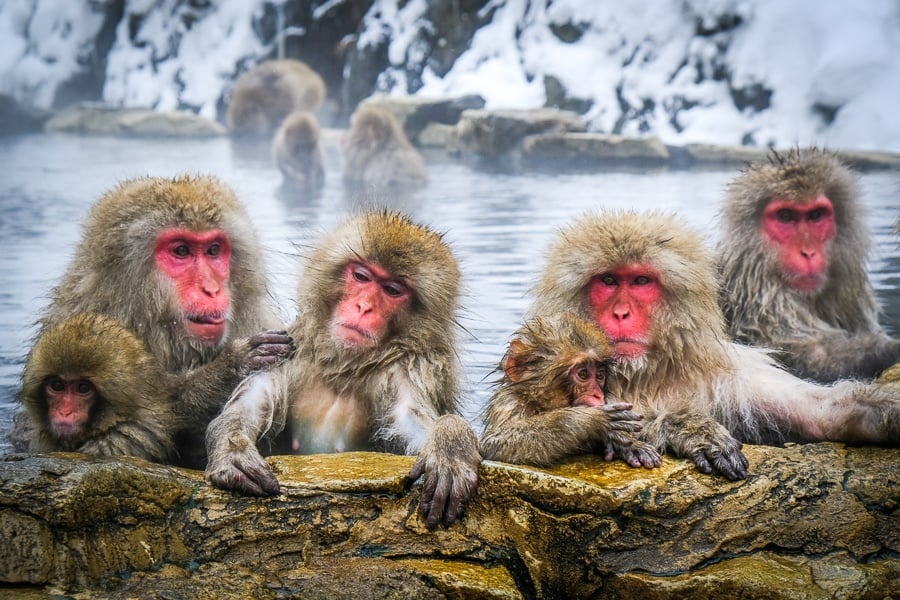Summary
One of the best things to do in Japan during the winter is to take a trip up north to visit the wild snow monkeys at Jigokudani Monkey Park, near Nagano.
During the winter (and sometimes summer), you can see numerous Japanese snow monkeys warming up in the natural hot springs, which provides excellent photo opportunities.
While the snow monkey park can be visited as a long day trip from Tokyo, it is even better to combine it with an excursion to Matsumoto Castle for a fulfilling 2-day trip from the capital.
This travel guide will explain how to get there and everything you need to know before your visit!
Visiting The Snow Monkey Park
The Jigokudani Monkey Park features a collection of natural hot springs in the mountains near Nagano, Japan, attracting hundreds of Japanese Macaques (commonly known as snow monkeys) that enjoy bathing in the warmth of the springs.
Located at the end of a 1.6-kilometer (1 mile) valley, reaching the monkeys requires a bit of easy hiking.
The park consists of just a few hot springs, a small gift shop, restrooms, and plenty of amusing monkeys.


Visitors can get surprisingly close to the monkeys, just one or two meters away, allowing for fantastic photos. Baby monkeys often join in the jacuzzi sessions as well.
The Japan snow monkeys are known for their relaxed demeanor, making them easy to photograph. Compared to the monkeys in the Ubud Monkey Forest in Bali, these monkeys are much more tame!
Although you shouldn’t bring any food, the monkeys are generally well-behaved and unlikely to steal your belongings.
Hours of Operation
- Summer: 8:30 – 17:00 (April to October)
- Winter: 9:00 – 16:00 (November to March)
Entrance Fee
- Adults: ¥800 ($7.35 USD)
- Kids 6-12: ¥400
- Kids 5 & Under: Free





How To Get To The Snow Monkey Park
The Jigokudani Monkey Park is situated in the Nagano prefecture of Japan.
The first step is to reach Nagano Station. Tokyo offers various train and bus options for this journey, and you can also explore routes from nearby regions.
Using Google Maps with Nagano Station as your destination will provide a comprehensive list of transport options.

Upon arriving at Nagano Station, take the east exit to find an express bus that goes directly to the park. The bus ride lasts about 45 minutes with a fare of ¥1,400 each way.
The first bus departs at 8:15 AM in winter, but schedules may vary by season. A full timetable is available at this website.
A combined ticket is also available, which includes round-trip bus fare and park admission for two days, priced at ¥3,500 in total (children pay half).
This option is especially beneficial for those planning to spend two days at the park, offering good value even for a single-day visit.

Hiking Trail To The Park
Upon arriving at the bus stop for the Snow Monkey Park, you will embark on a scenic 30-40 minute hike to reach the hot springs.
There’s no way to skip this hike, but the stunning snowy landscapes along the way make it one of the top highlights of the trip.
The trail can be a mix of snowy, muddy, or icy conditions with slight inclines, yet it remains manageable for most visitors, including families with children.
A small shack at the start of the hike offers crampons for rent to assist with traction, but they are often unnecessary, even in winter.
Any icy patches are easily spotted and can be avoided with careful observation.




Best Time To Visit
While snow monkeys can be spotted throughout the year, the optimal time to visit is during the snowy winter months from December to March.
You are almost guaranteed to see both snow and the monkeys if you choose to go in January or February.
Dress warmly for winter visits, as temperatures can drop to around 20-25°F (-5°C), significantly colder than Tokyo!
A heated gift shop near the springs allows visitors to warm up between monkey-viewing sessions, making it a comfortable stop during your adventure.


Visiting In Summer
If summer is your only option for visiting the park, you still have a fair chance of seeing the Japan snow monkeys, as the park staff regularly feeds them, encouraging their return.
However, during summer, monkeys might be less inclined to soak in the hot springs, which can limit your photo opportunities.
A live camera is available at the park’s official website to check monkey activity the day before your trip. Nonetheless, the season is a crucial factor—winter remains the best time for viewing!





